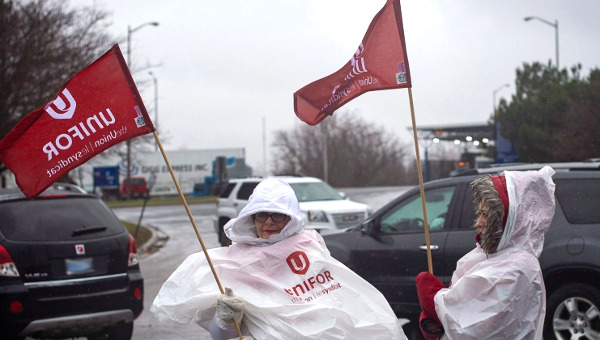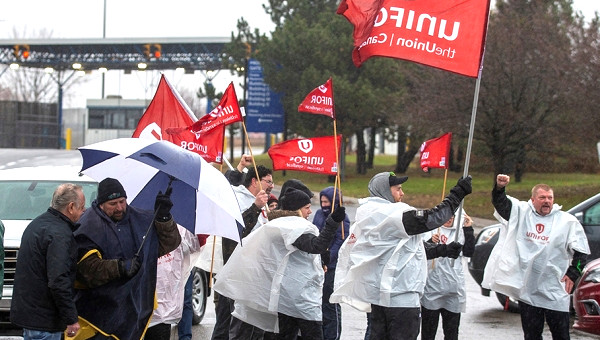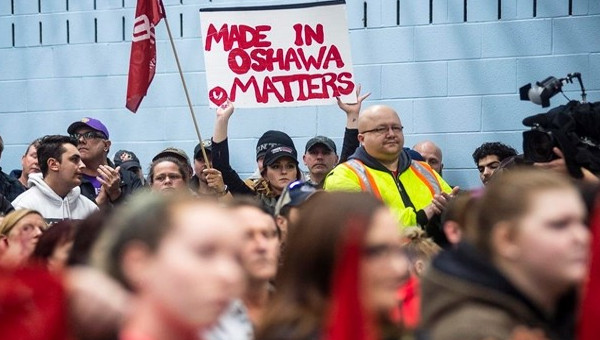After Another Setback Can Unifor Move On?
A four-week strike at the CAMI assembly plant, that began on September 17th, ended on October 16th. Members of Unifor Local 88 voted 86% in favour of the tentative agreement bargained with the stand-alone GM plant. Located in Ingersoll, Ontario, close to London, it is a former joint venture between Suzuki and GM. CAMI assembles hot-selling Chevrolet Equinox crossover vehicles.
 CAMI has an interesting history, and it is reflected in the membership of Local 88. It was originally opened in 1988 as a ‘model’ team concept plant. It integrated key elements of Lean Production – modeled on the Toyota Production System – with promises of ‘worker empowerment’ and job satisfaction. Suzuki’s production system attempted to combine notorious continuous work intensity practices (euphemistically referred to by the Japanese term for ‘continual improvement’ as kaizen), working in teams, and efforts to align the union with company goals. But Local 88, in partnership with the national union (Canadian Auto Workers (CAW) at the time), built a strong, independent and militant local union, relying on the critical thinking and ingenuity of the membership.
CAMI has an interesting history, and it is reflected in the membership of Local 88. It was originally opened in 1988 as a ‘model’ team concept plant. It integrated key elements of Lean Production – modeled on the Toyota Production System – with promises of ‘worker empowerment’ and job satisfaction. Suzuki’s production system attempted to combine notorious continuous work intensity practices (euphemistically referred to by the Japanese term for ‘continual improvement’ as kaizen), working in teams, and efforts to align the union with company goals. But Local 88, in partnership with the national union (Canadian Auto Workers (CAW) at the time), built a strong, independent and militant local union, relying on the critical thinking and ingenuity of the membership.
CAW sponsored a two-year participatory research project tracking the CAMI experiment and found – to no one’s surprise – that although CAMI was originally opened as a model team concept plant, it ended up being Just Another Car Factory (the title of a book on Local 88 and CAMI, subtitled Lean Production and Its Discontents).
A strike in 1992 continued the ongoing efforts of the local to limit and transform the company’s system of work intensity. In recent years, Suzuki pulled out and CAMI became part of the GM chain. But Local 88 was never fully integrated into the GM Master Agreement, bargaining separately, but tracking the pattern for the larger corporation.
Mixed Results
The settlement echoed the concessionary agreements that were bargained last fall at GM, Ford and Chrysler. There is a similar 10 year ‘grow-in’, acceptance of two-tier that was so contentious at Ford Oakville, Local 707. Pay and benefits tracked those contracts, (and it included a similar weighting in favour of lump sums and bonuses, rather than base rate increases). There were some popular gains, such as the inclusion of 10 days available as leaves of absence for domestic violence. The local also bargained increased funding to allow workers with 28 years seniority to grow-in to the 30 and Out pension, framed as a disincentive for GM to close or institute massive downsizing.
But this is only part of the story. This strike began with an unique central demand. That demand was audacious and radical – that GM designate CAMI as the lead plant for the production of Equinox now and in the future. In this era of free trade and the free movement of capital and investment, it would have limited GM’s freedom to invest where it wished. Fearful of possible plans to move Equinox production to Mexico (where two GM plants currently assemble it), that demand inspired the CAMI workers in a spirited strike. Their concern is not without foundation: this summer GM shifted production of the second-generation GMC Terrain crossover to Mexico, which resulted in about 400 people being laid off at CAMI. The strike touched a chord with the local community and many others. But it was lost – and, in retrospect, it appears that it never had any possibility of being won.
In general, the mood on the picket lines was spirited, hopeful and supportive and the mood of the workers after the ratification remains largely positive. The four week strike was deeply popular and participatory among the workers, auto workers at other plants and even the wider community. The local and rank and file members enthusiastically staffed the picket lines, and created a series of banners and art that called for maintaining their jobs here in Canada. There was support for the local leadership and the union as a whole. The local community was supportive of the principal demand and provided material support for the strikers. And, in spite of the ambivalent results, peoples’ spirits remained high after the ratification.
CAMI and NAFTA
The national union argued publicly about the danger of GM moving jobs out of the plant into Mexico, and demanded that NAFTA bargainers address the issue of Canadian auto jobs. Unifor National President Jerry Dias went to a number of NAFTA negotiation venues and argued that ending the low-wage regime and the lack of independent unions in Mexico and the so-called ‘Right to Work’ laws in the U.S. needed to be conditions of any new NAFTA. (As well, in the days immediately preceding the agreement, Unifor representatives held solidaristic meetings with independent Mexican trade unionists.)

But Dias was unwilling to differentiate the union’s interests from those of the Liberal government and spread illusions about the possibility of bargaining changes to NAFTA that could be friendly to working class interests. He also did not call for replacing NAFTA with a new Auto Pact (with content rules for each country). But it was important that the union’s larger concerns were articulated and found their way into the news.
The clear articulation of these two moments: the strike over GM’s right to move investment to other venues and the negotiations of the terms of investment and corporate power through NAFTA, would have presented an important opportunity to challenge GM, and the larger world of corporate investment. This articulation – one of the factors that drove the membership and community during the strike – did not happen. Why? And how should this strike be seen in an historical context?
Evaluating the Outcome
It is not a cynical ‘sellout’ as some (like the cynical WSW folks) have portrayed it to be. The local leadership was quite honest about their inability to get GM to budge on the central demand, and was not in a position to think through and give leadership to a larger struggle; that would have demanded a much deeper and wider strategic approach (not to mention a recent history of a buildup of confidence and capacities). While the original pattern agreement was full of concessions, this is not the same as ‘selling out’.
The problem goes deeper, and is rooted in Unifor’s auto sector bargaining strategy, and certainly precedes CAMI and the strike there.
The union’s National Office has a recent history of refusing to build a necessary fightback against the power of the auto companies on a number of levels: the challenge in the workplace to work intensity increases and lean production has vanished in the past decade; the steady disinvestment process, that included plant closures across the board at GM, Ford and Chrysler were not challenged (and instead included buyout and other benefits, which had no effect in limiting job losses). Think of the symbolic blockade of the management offices that the union organized when GM closed its truck plant in 2008 and didn’t include any collective challenge to production; the non-occupation of Caterpiller in London in 2012 – which also had broad community support at the time (see, “The Electro-Motive Lockout and Non-Occupation,” April 2012); the acceptance of the closures of the Chrysler and Ford Truck plants; the tenuous promises of production in the last GM agreement (and the rather sad example of the once-huge Oshawa complex, down to the level of the old Scarborough Van plant or Ford St. Thomas). As well, there was a refusal to see in the resistance to the pattern agreement among the rank and file and local leaders at Ford Oakville last fall, an opportunity to challenge and overturn two-tier – and instead, they saw it as a threat. It was clear that this was not really going to happen at CAMI, either.
There has been absolutely no larger strategic plan to counter the power of steady job loss and disinvestment in auto – either in resisting closures, demanding the reclamation of plants destined for closure, demands for products other than cars, trucks or SUVs, and no political demands to restructure the industry for the 21st century. Nor have there been demands for the Federal and Provincial governments to force the corporations to provide investment and job guarantees.
GM knew full well that Unifor had no plan to really challenge their ownership prerogatives at CAMI, because the union hasn’t fought over those issues since the 1996 occupation of the Oshawa North Plant over “Job Ownership.” (At that time, the CAW did run a province-wide campaign over the right to keep jobs safe from outsourcing, and won important if temporary and limited safeguards.) It would seem that all the brave talk about challenging GM was gone with the wind, when the corporation threatened to set in motion plans
to replace CAMI’s production in Mexico and cut off existing parts sourcing to the plant. Although similar threats were made in the 1980s, when the union challenged American concessions, the union clearly had no plan to challenge them this time (and unlike the 1980s, had not engaged in a series of struggles to create and build-on a culture of resistance to prepare members for struggle). It’s not as if those threats should be taken lightly – if GM were to cave in to these demands around CAMI, they would have become vulnerable to similar demands across the USA.
As dedicated and sincere the local leadership has been – and the support given from the local Ingersoll community – victory required a national campaign that would have had to combine direct, militant actions across the industry, and in alliance with other unions and communities. It would have required a war on a number of fronts, with an understanding of the sacrifices possibly necessary from members. This is precisely what didn’t happen at Caterpillar, either, with all of the support it had in the London community.
GM was well aware that this would not happen and it didn’t. The national leadership of Unifor raised some important themes in their campaign around NAFTA, but while it was tied to the Liberal government, it was not tied to the kind of independent ‘industrial’ and political action necessary to win. (More recently, the union has organized protests at Liberal MP’s offices.) Even then, it’s difficult to see how they could have won at CAMI. The larger war to challenge the power of GM and the auto companies might have seen a battle fought in CAMI, but the war would have required more battle fronts. As it worked out, one of the armies declared an armistice as soon as the roar of the guns were heard coming from the other side.
How to Move from Here?
In spite of the defeat of their main demand, the morale in CAMI after the bargaining seems quite positive: people didn’t fall further behind the economic pattern set in the albeit concessionary Detroit Three Master agreements, and strike participants were heartened by the community support they received. There is kind of a resigned acceptance and – quite frankly – a highly problematic dismissal of the possibility of challenging GM’s power. It’s almost as if the National Union’s clear abandonment of a larger perspective, has seeped down into the ranks of the membership. For now, there is a certain amount of confidence that the updated Equinox production will continue at CAMI for the near future. But there is no guarantee that the price of oil will remain low, and that any of the Canadian plants are necessarily safe from closure.
Unifor needs to rethink its close ties to the Liberal government, and its continued dependence on the Detroit three and their investment plans. It needs a strategic plan to defend the productive resources that the workers have built over the past decades, an approach that calls for producing needed public transit vehicles and components in plants that are at risk, and environmentally friendly vehicles at others. This has to be backed up with actions that challenge the corporations – much like the approach taken in the early days of building the union in the 1930s and the period when the CAW established itself as a voice against concessions in the 1980s. Massive educational and mobilizational efforts for the members and their communities are needed.
The Unifor leadership has instead, bought into the strategy of plant level competitiveness, which forces bargaining down to the level of negotiating unit costs for each company, concessions, lobbying the state for increased investment in the sector through Research and Development support and direct subsidies to individual plants, and regulatory accommodations in trade agreements. The implicit political pact that exists between Unifor and the Liberal Party tends to recall the old-style Lib-Lab partnerships of the past. This can only lead to further concessions and political defeats for working class ambitions down the road.
But this won’t come about by itself. The leadership strata in Unifor haven’t been part of any radical strategic orientation for most of their careers. The rank and file and secondary leadership have been trained to accept the kind of limited approach the union has taken
for the past decade or so. It can only change with an explicit political turn inside the union’s membership, and a socialist political movement that does not see private ownership without controls on capital as sacrosanct and fosters a larger vision of the ecological transition needed in the transportation sector under the constraints of climate change. •






